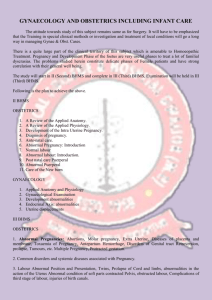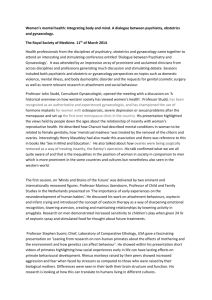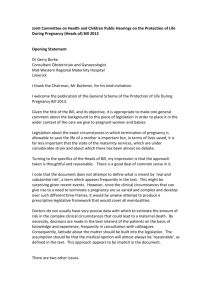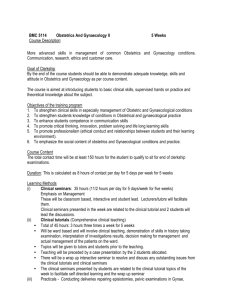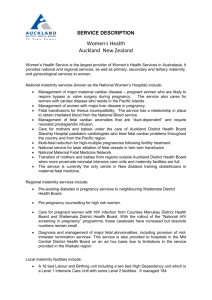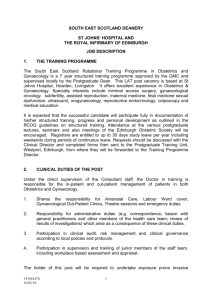Delemne 4.3: Obstetrics and Gynaecology Part of Curriculum: MED
advertisement
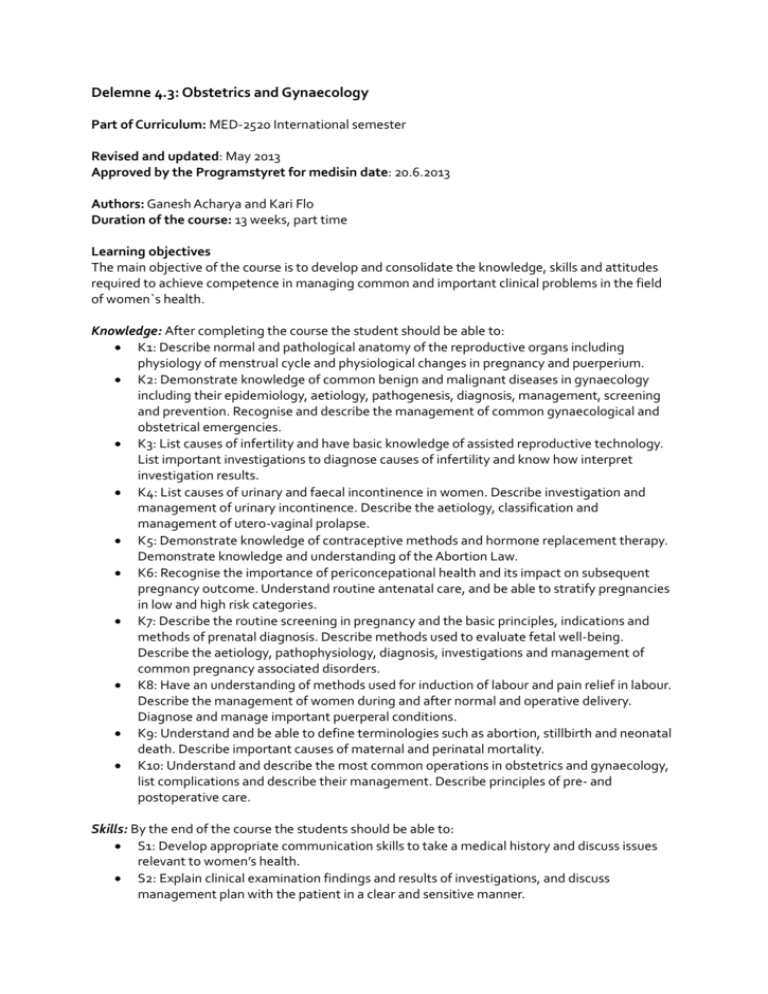
Delemne 4.3: Obstetrics and Gynaecology Part of Curriculum: MED-2520 International semester Revised and updated: May 2013 Approved by the Programstyret for medisin date: 20.6.2013 Authors: Ganesh Acharya and Kari Flo Duration of the course: 13 weeks, part time Learning objectives The main objective of the course is to develop and consolidate the knowledge, skills and attitudes required to achieve competence in managing common and important clinical problems in the field of women`s health. Knowledge: After completing the course the student should be able to: K1: Describe normal and pathological anatomy of the reproductive organs including physiology of menstrual cycle and physiological changes in pregnancy and puerperium. K2: Demonstrate knowledge of common benign and malignant diseases in gynaecology including their epidemiology, aetiology, pathogenesis, diagnosis, management, screening and prevention. Recognise and describe the management of common gynaecological and obstetrical emergencies. K3: List causes of infertility and have basic knowledge of assisted reproductive technology. List important investigations to diagnose causes of infertility and know how interpret investigation results. K4: List causes of urinary and faecal incontinence in women. Describe investigation and management of urinary incontinence. Describe the aetiology, classification and management of utero-vaginal prolapse. K5: Demonstrate knowledge of contraceptive methods and hormone replacement therapy. Demonstrate knowledge and understanding of the Abortion Law. K6: Recognise the importance of periconcepational health and its impact on subsequent pregnancy outcome. Understand routine antenatal care, and be able to stratify pregnancies in low and high risk categories. K7: Describe the routine screening in pregnancy and the basic principles, indications and methods of prenatal diagnosis. Describe methods used to evaluate fetal well-being. Describe the aetiology, pathophysiology, diagnosis, investigations and management of common pregnancy associated disorders. K8: Have an understanding of methods used for induction of labour and pain relief in labour. Describe the management of women during and after normal and operative delivery. Diagnose and manage important puerperal conditions. K9: Understand and be able to define terminologies such as abortion, stillbirth and neonatal death. Describe important causes of maternal and perinatal mortality. K10: Understand and describe the most common operations in obstetrics and gynaecology, list complications and describe their management. Describe principles of pre- and postoperative care. Skills: By the end of the course the students should be able to: S1: Develop appropriate communication skills to take a medical history and discuss issues relevant to women’s health. S2: Explain clinical examination findings and results of investigations, and discuss management plan with the patient in a clear and sensitive manner. S3: Develop basic communication skills in breaking bad news such as intrauterine fetal death, gynaecological malignancy etc. S4: Perform vaginal speculum examination and bimanual pelvic examination. S5: Take appropriate and relevant microbiological and cytological samples. S6: Insert and remove an intrauterine contraceptive device and implant. S7: Perform obstetric examination (antenatally, during labour and postpartum). Attitude: The student should be able to: A1: Practise with a professional appearance and caring attitude. Support and respect the women’s choices and decisions. Understand the importance of teamwork. A2: Set at ease a woman presenting with gynaecological problems so that she feels comfortable and confident enough to give a complete history and consent to examination. A3: Show respect and understanding to various emotions that a pregnancy may cause and use appropriate wording to the questions asked. Teaching and Learning Methods: The learning objective will be achieved by using a variety of teaching methods: Lectures, seminars and small group work Practical laboratory work, simulations, training in the skills laboratory using phantoms and models (see separate document regarding the skills taught in the skills lab) Clinical case presentations, bedside teaching, and observation of the clinical tasks performed by the peers. Seminars: 2 hour seminars for small groups (10-12 students) using real clinical scenarios. 1) Dysfunctional uterine bleeding and contraception 2) Early pregnancy problems and pelvic infections 3) Management of normal labour 4) Management of abnormal labour Clinical Practice: Shadowing on-duty doctors (1 day from 15:00 to 23:00 hours): optional Bed-side teaching in group with one teacher (1 hour). Gynaecological ward (1 day, take history and examine one patient). Gynaecology clinic (1 day). Antenatal clinic (1 day). Obstetric ward (two 8-hours shifts in the labour ward, attend at least one delivery). Additional clinical practice is arranged for Norwegian students during the 6th year but in 4th year for International Exchange students. Mandatory attendance/ approval required Skills lab 2 sessions and labour ward (one delivery) are mandatory. Clinical aspects from the list of 115 82 Urinary incontinence (female) 87 Pregnancy /labour 89 Menstrual disorders 91 Pelvic pain 86 Vaginal discharge 88 Infertility/sexual dysfunction 90 Abnormal vaginal bleeding 92 Vulval itching/ulceration Recommended Learning Resources Bergsjø P, Maltau JM, Molne K, Nesheim BI: Obstetrikk og Gynekologi. Gyldendal Akademisk. Impey L. Child T. Obstetrics and Gynaecology 4. ed. Willey-Blackwell, 2012 . International exchange students may use textbooks as advised by their respective institutions.
